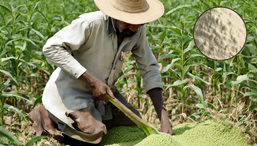Guar gum comes from guar plant seeds and is a versatile material used in different industries like food, medicine, and beauty products. However, Guar Gum Farming has its own difficulties and chances. In this blog, we will look into the details of farming guar gum, talking about the problems farmers deal with and the good opportunities that are gained from it.
Challenges in Guar Gum Farming:
- Climate Sensitivity: Guar plants are highly sensitive to climate conditions. They thrive in warm and arid regions, making them susceptible to adverse weather changes. Sudden shifts in temperature or unexpected rainfall can negatively impact the yield, posing a challenge for farmers.
- Pest Infestations: Like many crops, guar plants are susceptible to various pests and diseases. Pests such as aphids and mites can damage the plants, leading to reduced yields. Farmers need to implement effective pest management strategies to protect their crops and ensure a healthy harvest.
- Water Requirements: Guar plants demand a significant amount of water for proper growth. In regions facing water scarcity, this becomes a major challenge. Sustainable water management practices, such as drip irrigation and rainwater harvesting, are crucial for guar gum farming.
- Limited Agricultural Knowledge: In some areas where guar gum farming is prevalent, farmers may lack access to modern agricultural practices. Limited knowledge about advanced farming techniques, soil health, and crop management can hinder the overall productivity of guar crops.
- Market Fluctuations: Guar gum prices are subject to market fluctuations, which can impact the income of guar gum farmers. A sudden drop in prices can lead to financial instability for farmers who heavily depend on guar cultivation.

Opportunities in Guar Gum Farming
- Growing Demand in Industries: Guar gum is widely used in various industries, including food, pharmaceuticals, and cosmetics. The increasing demand for natural and organic products has boosted the market for guar gum. This presents a significant opportunity for farmers to tap into a growing and diverse consumer base.
- Diversification of Products: Beyond traditional uses, guar gum has found applications in hydraulic fracturing in the oil and gas industry. This diversification provides farmers with the opportunity to explore different markets and potentially increase their income.
- Research and Development: Ongoing research and development in agriculture have led to the development of improved guar varieties that are more resilient to pests and diseases. Farmers can benefit from adopting these advancements to enhance the overall yield and quality of their guar crops.
- Government Support and Initiatives: In several countries, governments are recognizing the potential of guar gum farming and are implementing supportive policies. Subsidies, financial aid, and training programs can empower farmers, enabling them to overcome challenges and thrive in the guar gum industry.
- Export Opportunities: Guar gum has a significant presence in the international market. Exporting guar gum products can be a lucrative opportunity for farmers. Understanding international quality standards and regulations is crucial for those looking to tap into global markets.
Sustainable Practices for Guar Gum Farming
- Crop Rotation: Implementing crop rotation practices helps maintain soil fertility and reduces the risk of pest and disease buildup. Alternating guar crops with other compatible plants can contribute to a healthier farming ecosystem.
- Water Conservation Techniques: Given the water-intensive nature of guar crops, adopting water conservation techniques is essential. Techniques such as rainwater harvesting, efficient irrigation methods, and soil moisture management can help farmers make the most of available water resources.
- Training and Education: Providing farmers with access to training programs and educational resources is crucial for enhancing their agricultural knowledge. Workshops on modern farming practices, pest management, and sustainable agriculture can empower farmers to make informed decisions.
- Collaboration and Networking: Encouraging farmers to collaborate and network with agricultural experts, research institutions, and industry stakeholders can foster a supportive community. Sharing experiences and knowledge can contribute to the overall growth of the guar gum farming sector.
Conclusion:
Guar gum farming, despite its challenges, holds immense potential for farmers worldwide. By addressing issues such as climate sensitivity, pest infestations, and water scarcity through sustainable practices, farmers can unlock the opportunities presented by the growing demand for guar gum in various industries. Government support, research advancements, and a focus on education and collaboration can further propel the guar gum farming sector into a sustainable and prosperous future. As the global market for natural products continues to expand, guar gum farmers stand at the forefront of a promising agricultural landscape.
FAQs:
1. What is guar gum?
Guar gum is a versatile substance derived from guar plant seeds, widely used in food, pharmaceuticals, and cosmetics.
2. Why is guar gum farming challenging?
Guar gum farming faces challenges like climate sensitivity, pest infestations, and the need for a significant amount of water.
3. How does climate affect guar gum farming?
Guar plants prefer warm and arid climates; sudden temperature changes or unexpected rainfall can impact their growth.
4. What pests affect guar crops?
Guar crops can be affected by pests like aphids and mites, which can damage the plants and reduce yields.
5. How does guar gum benefit gluten-free baking?
Guar gum helps hold ingredients together in gluten-free baking, preventing treats from collapsing and maintaining their shape.
6. What role does research play in guar gum farming?
Ongoing research helps develop improved guar varieties, making them more resilient to pests and diseases.
7. How can farmers address water scarcity in guar gum farming?
Farmers can adopt water conservation techniques such as drip irrigation and rainwater harvesting.
8. What government support is available for guar gum farmers?
Governments may offer subsidies, financial aid, and training programs to support guar gum farmers.
9. How does guar gum contribute to the international market?
Guar gum has a significant presence in the global market, presenting export opportunities for farmers.
10. What can farmers do to enhance guar gum farming sustainability?
Farmers can implement sustainable practices like crop rotation, water conservation, and collaboration with agricultural experts.


